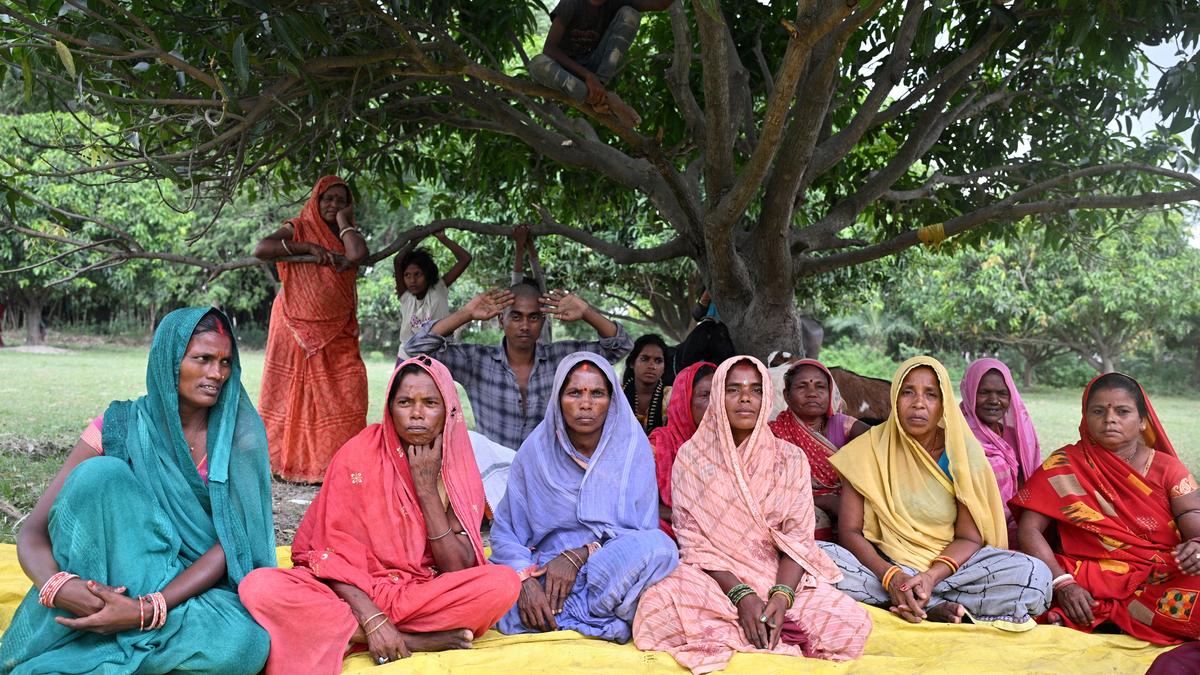Copyright thehindu

Sanjula Devi still remembers the first microfinance loan she took — ₹20,000 in 2012 — to repay earlier amounts borrowed from the village moneylender. “The first loan, yes, I took it to repay older debts,” she says, her voice steady but weary as she sits on the floor in her small home in Bihar’s Bijuli village, just off the National Highway near Darbhanga town. The loan came from Fusion Bank, a microfinance company, and was taken as part of a women’s group of twelve, each member borrowing ₹20,000 with a monthly repayment of ₹1,200. Her husband worked as a labourer, and she did daily-wage work. With three children and no land or other income, even this small installment was a struggle. “Sometimes I earn ₹500 a day, sometimes less. I managed to save and pay back slowly,” she recalls. That first loan was repaid, but over time, more loans were taken from the government’s self-help group programme Jeevika, from Fusion, and Belstar, another microfinance company, eventually totalling nearly ₹4 lakh, with repayment schedules sometimes as high as ₹4,040 per month. “With that little income, how could we pay so much?” she asks. Her husband could not bear the mounting debt. “He was quiet, worried, and could not bear it anymore. The microfinance agents used to call and pressure him. Eventually, he took his own life,” Ms. Sanjula says. Her children were ten, twelve, and fifteen at the time. Largest microfinance portfolio According to the Bharat Microfinance Report by Sa‑Dhan, an RBI-appointed self-regulator for the microfinance sector, Bihar alone accounted for nearly 15 % of the industry portfolio, making it the single largest State portfolio in the country. Outstanding microfinance loans in Bihar amounted to ₹57,712 crore as of March 2025. As the State heads to the polls, however, with the second phase of voting set for November 11, the promise of financial empowerment remains out of reach for many households. “Microfinance was meant to empower women, but we never taught them how to manage credit,” says Mohit Sinha, a social worker who has worked across south Bihar. Most borrowers, he adds, sign papers they don’t fully understand. “They trust the field officers or the group leader. There should have been financial training with every loan, but that never happened.” Instead, the never-ending cycle of relentless financial pressure, daily survival, and mounting debt has overtaken many of Bijuli’s mud houses and narrow lanes. Empty political promises Anita Devi lives with six family members; only two of whom earn through irregular daily labour. Her income barely meets basic needs. Government rations are inconsistent, leaving her dependent on loans. She took her first loan of ₹1.25 lakh for her son’s wedding, even though such loans are officially for business purposes. Later, she borrowed from multiple sources in the village, sometimes ₹50,000, sometimes ₹30,000 or ₹10,000, gradually accumulating heavy debt. Repayment is enforced rigorously. Loan agents arrive repeatedly, sometimes sitting at the house all day until payment is made. Installments may be small, but fines and extra interest quickly pile up. “If the person is not home, they still won’t leave,” Ms. Anita explains. She tries to repay by weaving baskets and making brooms, selling them along the highway. Yet, even after months of effort, the debt remains. “Politicians promise a lot, especially before elections, but when it comes to helping people like us, nothing reaches us. We are left to fend for ourselves,” she says. ‘Old debts never end’ Shila Devi’s story mirrors the relentless cycle. Years ago, her husband was beaten and critically injured. She borrowed ₹2 lakh for his treatment, moving him between three hospitals and seeking help from multiple villages while struggling to feed her four daughters and one son. Even after multiple loans, the debt kept growing. “We think, if we take one more loan, we will clear the old ones,” she says quietly. “But the old debts never end.” “There’s no one earning in the family,” she adds. “How could I repay the loan? My husband is sick. How could I repay?” Collectors would come repeatedly, shouting and arguing, sometimes frightening her children. Today, Ms. Shila earns a little through small labour jobs, but the debt remains. She has left her husband’s home and now lives with her mother to avoid constant visits from the debt collectors. “If anyone lends us money today, we take it only to survive. No one gives loans easily now,” she says. System built on pressure The system behind these loans is tightly structured. Ranju Kumari, who works with Jeevika women’s groups, explains that women are grouped in clusters of ten to twelve. If one cannot pay, the others must cover her share. A leader collects repayments and takes commissions. Insurance is deducted, but often the funds never reach families in need. Interest rates are strict, around 21-22%. “No one borrows for pleasure. The poor have no choice. Now every house has one or two loans,” she says. Within microfinance companies, pressure exists for employees, too. Raju Sah, a branch manager of Annapoorna Finance, says the sector is regulated by the RBI, and loans are now linked to borrowers’ credit histories. “We’ve reduced targets,” he says, “but repayment has to be punctual. When money is used for things that don’t bring income, repayment becomes difficult.” Ravi Kumar, a field collector, spends his days travelling between villages, handling more than two hundred clients. “If someone can’t pay, we still have to recover the amount,” he says. “Agents get abused, too. I’ve used my own salary to cover missed instalments.” He describes it as a job with constant tension, stuck between company targets and public anger. Endless cycle of stress For women like Sanjula, Shila, and Anita, the cycle never ends. Loans are taken to repay earlier debts or manage household needs, only to be replaced by new ones. They borrow for school fees, medicine, weddings, or even food. Repayment visits continue, sometimes weekly, sometimes more, and the stress is constant. Despite the hardships, the women persist because they hope each installment will bring relief. “We think, if we pay one more, it will finish,” says Ms. Shila. Ms. Sanjula carefully folds her passbook, while Ms. Anita weaves baskets and brooms, earning what she can to meet repayments. Each woman continues day after day, navigating a system that ties survival to debt.



